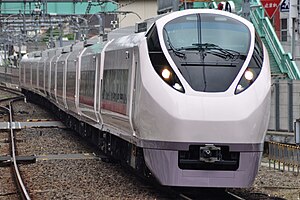E657 series
| E657 series | |
|---|---|

Set K-1 undergoing test running, May 2011
|
|
| In service | 3 March 2012 |
| Manufacturer | Hitachi, J-TREC, Kinki Sharyo |
| Replaced | 651 series, E653 series |
| Constructed | 2011-2014 |
| Number built | 170 vehicles (17 sets) |
| Number in service | 160 vehicles (16 sets) |
| Formation | 10 cars per trainset |
| Fleet numbers | K-1–K-17 |
| Capacity | 600 (Green: 30, Standard: 570) |
| Operator(s) | JR East |
| Depot(s) | Katsuta |
| Line(s) served | Joban Line |
| Specifications | |
| Car body construction | Aluminium alloy |
| Car length | 21,100 mm (69 ft 3 in) (end cars) 20,000 mm (65 ft 7 in) (intermediate cars) |
| Width | 2,946 mm (9 ft 8.0 in) |
| Height | 4,249 mm (13 ft 11.3 in) |
| Doors | 1 per side (2 on end cars) |
| Maximum speed | 130 km/h (80 mph) |
| Traction system | Variable frequency (IGBT) |
| Acceleration | 2.0 km/h/s |
| Deceleration | 5.2 km/h/s |
| Electric system(s) | 1,500 V DC / 20 kV AC overhead wire |
| Current collection method | PS37A pantograph |
| Bogies | DT78 (motored), TR263 (trailer) |
| Safety system(s) | ATS-P, ATS-Ps |
| Track gauge | 1,067 mm (3 ft 6 in) |
The E657 series (E657系?) is an AC/DC dual-voltage electric multiple unit (EMU) train type operated by East Japan Railway Company (JR East) in Japan on limited express services between Ueno in Tokyo and Iwaki on the Joban Line since March 2012.
The trains replaced the 651 series and E653 series EMUs previously used on Super Hitachi and Fresh Hitachi limited express services on the Joban Line. The first train in revenue service ran on 3 March 2012, in the form of a special return Hula Girl limited express service between Ueno and Iwaki, with regular scheduled services starting from the revised timetable on 17 March 2012. The initial order of sixteen 10-car sets was in service by the start of the revised timetable on 16 March 2013.
The front end design is derived from the earlier Super Hitachi 651 series trains, and the pale pink body colour with red lining is intended to evoke an image of the ume plums for which the area served by the trains is famous.
The end cars and Green (first class) cars feature full active suspension for improved ride quality, and yaw dampers are fitted between cars.
The DT78 (motored) and TR263 (trailer) bolsterless bogies are developed from the DT77 and TR262 bogies used on the E259 series EMUs, with improvements to cope with the increased vehicle weight and provide increased snow and cold weather resistance. The end bogies of the Tc driving cars are designated TR263, the inner bogies of the Tc driving cars and the Ts car are designated TR263A, and the bogies on the T1 car are designated TR262B. All the bogies use tread brakes, and the trailer bogies additionally use two disc brakes per axle. Wheel diameter is 860 mm, and the distance between wheel centres is 2,100 mm.
...
Wikipedia
